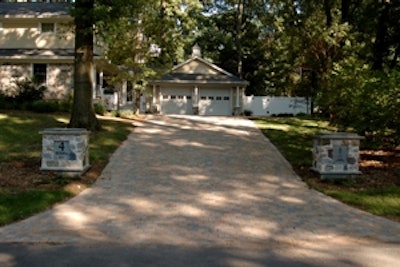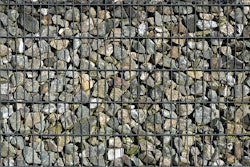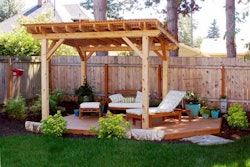
In the two-year pilot project phase underway for the Sustainable Sites Initiative (SITES), pre-design and design prerequisites assume a very high profile. In fact, site selection, pre-design assessment and site design account for 75% of the total points available under SITES.
But that doesn’t mean the rating and credit system is set in stone. In fact, one of the goals of the two-year pilot and accompanying projects is to test its efficacy, according to American Society of Landscape Architects (ASLA) spokesperson Jim Lapides. “Depending on the type and diversity of projects submitted, we may have upwards of 200 from all different parts of the country. The information we gather will help determine how real-to-life the SITES rating and credit system is.
“Ultimately the credits are supposed to accomplish something in a reasonable and cost-effective way,” Lapides continues. “But maybe planning costs would be prohibitive for achieving some credits, or reducing water consumption by 50% would be unobtainable in some areas of the country. That’s what the pilot program is designed to tell us.” Lapides explains that once the program has been completed and data gathered and analyzed, SITES will publish another report that updates the rating and credit system, replete with case study results. The report can then be used by landscape contractors as a more definitive source of ways to design, install and maintain sustainable projects.
Landscape contractors, though, need not wait for the final report to test and even hone their “green” skills. The SITES pilot project—the result of nearly five years of benchmarking, public comment and case study review—provides a good initial roadmap for offering customers sustainable solutions.
Preserve and Repair Existing Resources
The SITES guidelines call for the design team to select building sites with a view toward preserving existing resources and repairing damaged systems, and otherwise planning for sustainability from the onset of the project. Dean DeSantis, president of DeSantis Landscapes in Salem, OR, says that a team approach, or integrative design, works best for designing sustainability into the early stages of a project. He tells how a multi-disciplinary team comprised of, for example, the building architect, property owner, mechanical engineer and landscape designer, can add value by looking at a project in a holistic manner as opposed to the single dimension of each discipline.
“We’ve participated in brainstorming sessions where participants tossed around ideas about how to make the site as sustainable and efficient as possible,” DeSantis tells. “Among considerations, a team looks at the solar orientation of the home, drainage patterns (where the water naturally flows), and the native flora and fauna of the site. Understanding grades and the natural lay of the land is critical. What you don’t want, for example, is to construct a driveway that slopes toward the home, or destroy key habitat for local fauna. Ideally you would like to treat all the stormwater while on-site by slowing it down and filtering it before it leaves the site.”
Protecting existing plants and trees may also be a high priority in the early stages of project design, according to DeSantis. If certain species cannot be spared, then possibly transplanting them to another site would be feasible.
Richard Heller, president of Greener by Design in Pelham, NY, agrees. He believes that people should spare trees that are older than themselves. “But at the same time, we’re not the ones paying for design and construction. We have to educate property owners who ultimately must decide if being sustainable is cost-effective for them.
“Our company doesn’t sell sustainability up front,” Heller adds. “Instead, we look at the initial design from a purely aesthetic perspective, and then present the property owner with several different options. Then, when pulling out a contract, we talk about sustainable options.”
Preserving as many native plants as possible is one of those options. “You can encourage customers to avoid removing trees that take a long time to grow, especially hardwood trees,” Heller explains. “Big trees not only provide shade, sequester carbon dioxide and produce oxygen, but also add aesthetic value to a property. You can talk about controlling or eliminating invasive species and replacing them with native and acclimated native species.
“In terms of repairing damaged sites, introducing plants that absorb metals in the soil can actually help clean up toxic sites,” Heller goes on to say. “And don’t underestimate the value of a soil test.”
Managing Water
Protecting and restoring water can mean either keeping stormwater on site or slowing it down to give it time to be cleansed before leaving the property. Rain gardens comprised of native plants, rushes and sedges have become popular. So have cisterns that collect and feed rainwater to irrigation systems. DeSantis’ company also advises clients to divert downspouts to a “dry creek” bed, bio-swale or pond area that will fill and slowly release the water back into the soil during rainy Northwest winters.
Properly designed irrigation systems and the use of drought-tolerant plants will relieve pressure on water resources. And, as DeSantis has demonstrated on projects, replacing old hardscaping elements with new permeable material will minimize runoff.
“Finding ways to eliminate the use of potable water in landscaping elements will help protect this vital resource,” adds Heller. “Innovative products such as ornamental water features that re-circulate rainwater work to this end.”
Protect and Restore Soil and Vegetation
Heller re-emphasizes the important role that soil plays in the mix of reducing a property’s carbon footprint. “Minimizing the use of heavy machines reduces harmful compaction, while saving topsoil during excavation is less expensive and time-consuming than restoring it later on,” Heller says.
“Saving existing topsoil for reuse on a site is ideal, but one needs to allocate space for the effort and keep it covered and dry,” adds DeSantis. “However, there are certainly times when it just isn’t practical or cost-effective.”
DeSantis also advises putting together a tree preservation plan and incorporating regionally adapted plants to help broaden the palette. As he describes, “Our region here in the Northwest has a very similar climate to the Mediterranean, so plants that are native to that region also do well here.”
Diversity can go beyond adding aesthetic value, Heller explains. “Biomass is a term that emerges when one researches the value of sustainable landscapes. It involves adding diversity to landscapes by layering plant material. The strategy encourages wildlife and beneficial insects, optimizes carbon sequestration, and promotes a more complex and healthier ecosystem overall.”
This approach, Heller admits, comes at the expense of turfgrass. However, reducing unnecessary lawn area (such as on the sides of a home or in back areas), depending on a family’s needs, saves on watering, mowing and other maintenance practices, and reduces the use of fertilizers and pesticides.
Reuse and Recycle Existing Materials
“Sustainability, for me, is less about global warming and more about reducing waste,” DeSantis emphasizes. “If you’re not participating or have no plans to participate, then you’re wasting resources not only for your business and your clients, but for future generations.”
One way to reduce waste is to reuse and recycle existing site materials. “I designed and built a project a few years ago that was using sustainable practices before sustainability became so popular,” recalls Jody Shilan, president of the New Jersey Landscape Contractors Association and owner of Jody Shilan Designs. “I think we were more concerned about controlling costs than saving resources back then.”
Shilan, who has a master’s degree in landscape architecture, explains some of his sustainable solutions. “At one residence, I removed an existing deck prior to the renovation of the house, and reused all the pressure-treated lumber to frame the new deck and even build a trellis. We created a pool patio from pavers that were removed from another client’s house where we had demolished their pool and patio.”
Shilan goes on to explain that the walkways and driveway borders were made of recycled brick from another project. The driveway was constructed from leftover pavers from several projects, creating a special blend. A large boulder, removed during construction, was engraved and set at a public garden installation.
“Again, I think it was more about being cost-conscious than being overly aware of the environment,” Shilan emphasizes. “Either way this project demonstrates that by being more creative, almost any contractor can participate in the sustainable movement without going over the top.”
Technology is helping, too, Shilan adds. “I recall seeing a piece of equipment at our trade show that can crush concrete and brick on site so contractors can reuse the material immediately for base material when installing a new patio or driveway.”
At a Minimum
As these landscape contractors point out, one doesn’t need a Ph.D. in environmental science to design sustainability into projects, and ultimately the onus is on customers to determine their shade of green. That doesn’t relieve landscape designers and contractors from their responsibility as stewards of the environment and of their industry.
“As stewards of the environment, we are charged with the responsibility to understand the basics and offer them as options for customers,” says Heller. “We have to be knowledgeable about invasive species, be aware of the benefits large shade trees provide, and understand the role soil plays in the evolution of ecosystems.
“As a member of the Green Industry, we also have the responsibility to protect our livelihood,” Heller adds. “We have to be in a position to defend ourselves from those who claim that we do more damage than good when we design, install and maintain landscapes. We know better, and our job is to convey that message to our customers and the general public. Understanding SITES and how we can incorporate its guidelines into our processes is a big step in that direction.”




















